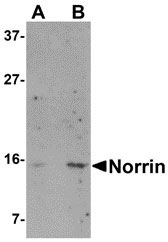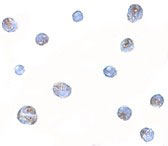Norrin Antibody
- 产品详情
- 实验流程
- 背景知识
Application
| WB, ICC, E |
|---|---|
| Primary Accession | Q00604 |
| Other Accession | NP_000257, 4557789 |
| Reactivity | Human |
| Host | Rabbit |
| Clonality | Polyclonal |
| Isotype | IgG |
| Calculated MW | 15044 Da |
| Concentration (mg/ml) | 1 mg/mL |
| Conjugate | Unconjugated |
| Application Notes | Norrin antibody can be used for detection of Norrin by Western blot at 1 - 2 µg/mL. Antibody can also be used for immunocytochemistry starting at 5 µg/mL. |
| Gene ID | 4693 |
|---|---|
| Other Names | Norrin, Norrie disease protein, X-linked exudative vitreoretinopathy 2 protein, NDP, EVR2 |
| Target/Specificity | NDP; |
| Reconstitution & Storage | Norrin antibody can be stored at 4℃ for three months and -20℃, stable for up to one year. As with all antibodies care should be taken to avoid repeated freeze thaw cycles. Antibodies should not be exposed to prolonged high temperatures. |
| Precautions | Norrin Antibody is for research use only and not for use in diagnostic or therapeutic procedures. |
| Name | NDP |
|---|---|
| Synonyms | EVR2 |
| Function | Activates the canonical Wnt signaling pathway through FZD4 and LRP5 coreceptor. Plays a central role in retinal vascularization by acting as a ligand for FZD4 that signals via stabilizing beta-catenin (CTNNB1) and activating LEF/TCF-mediated transcriptional programs. Acts in concert with TSPAN12 to activate FZD4 independently of the Wnt- dependent activation of FZD4, suggesting the existence of a Wnt- independent signaling that also promote accumulation the beta-catenin (CTNNB1). May be involved in a pathway that regulates neural cell differentiation and proliferation. Possible role in neuroectodermal cell-cell interaction. |
| Cellular Location | Secreted. |
| Tissue Location | Expressed in the outer nuclear, inner nuclear and ganglion cell layers of the retina, and in fetal and adult brain |
For Research Use Only. Not For Use In Diagnostic Procedures.
Provided below are standard protocols that you may find useful for product applications.
BACKGROUND
Norrin Antibody: Norrie disease is an X-linked genetic disorder characterized by progressive atrophy of the eyes, mental disturbances and deafness. The gene responsible for this disease was initially identified through positional cloning. Norrin, the gene product, encodes a small secreted, cysteine-rich protein that is thought to act as a ligand for the Wnt-receptor/beta-catenin signal pathway despite having sequence homology with the Wnt family of proteins. Mice lacking this gene have abnormal blood vessel growth in the vitreous and a disorganized retina; transgenic ectopic expression of Norrin restores normal retinal vasculature. Recent evidence shows that Norrin can attenuate tPA and uPA-mediated death of transformed rat retinal ganglion cells (RGC-5) by activating the Wnt/beta-catenin pathway and regulating the phosphorylation of LRP-1, a cell surface receptor for tPA and uPA, suggesting the Norrin may function in vivo by regulating kinases which may alter the phosphorylation of LRP-1.
REFERENCES
Bergen W, Meindl A, van de Pol TJ, et al. Isolation of a candidate gene for Norrie disease by positional cloning. Nat. Genet.1992; 1:199-203.
Meitinger T, Meindl A, Bork P, et al. Molecular modelling of the Norrie disease protein predicts a cysteine knot growth factor tertiary structure. Nat. Genet.1993; 5:376-80.
Xu Q, Wang Y, Dabdoub A, et al. Vascular development in the retina and inner ear: control by Norrin and Frizzled-4, a high-affinity ligand-receptor pair. Cell2004; 116:883-95.
Ohlmann A, Scholz M, Goldwich A, et al. Ectopic norrin induces growth of ocular capillaries and restores normal retinal angiogenesis. J. Neurosci.2005; 25:1701-10.
终于等到您。ABCEPTA(百远生物)抗体产品。
点击下方“我要评价 ”按钮提交您的反馈信息,您的反馈和评价是我们最宝贵的财富之一,
我们将在1-3个工作日内处理您的反馈信息。
如有疑问,联系:0512-88856768 tech-china@abcepta.com.























 癌症的基本特征包括细胞增殖、血管生成、迁移、凋亡逃避机制和细胞永生等。找到癌症发生过程中这些通路的关键标记物和对应的抗体用于检测至关重要。
癌症的基本特征包括细胞增殖、血管生成、迁移、凋亡逃避机制和细胞永生等。找到癌症发生过程中这些通路的关键标记物和对应的抗体用于检测至关重要。 为您推荐一个泛素化位点预测神器——泛素化分析工具,可以为您的蛋白的泛素化位点作出预测和评分。
为您推荐一个泛素化位点预测神器——泛素化分析工具,可以为您的蛋白的泛素化位点作出预测和评分。 细胞自噬受体图形绘图工具为你的蛋白的细胞受体结合位点作出预测和评分,识别结合到自噬通路中的蛋白是非常重要的,便于让我们理解自噬在正常生理、病理过程中的作用,如发育、细胞分化、神经退化性疾病、压力条件下、感染和癌症。
细胞自噬受体图形绘图工具为你的蛋白的细胞受体结合位点作出预测和评分,识别结合到自噬通路中的蛋白是非常重要的,便于让我们理解自噬在正常生理、病理过程中的作用,如发育、细胞分化、神经退化性疾病、压力条件下、感染和癌症。







